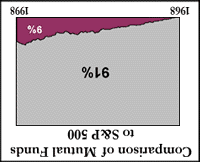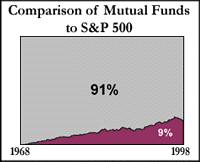Since our company's humble beginning in 1994, we've striven to teach investors a simple lesson: manage your own money. Why? Well, for one reason, because we believed that 91% of professionally-managed mutual funds in the U.S. have lost to the stock market's average gain over the past five years.
"Why does the mutual-fund industry even exist? Why do people pay these overhigh fees for consistent underperformance of the average?" we asked America on CBS This Morning this past January.
We've championed this idea around America for four years now -- on our online site, in our books, and before countless national television and radio audiences. We've considered it to be one of our most important educational messages for the American investor.
And now, due to recent findings, we must humbly admit that we were FLAT WRONG.
This is going to come as a shock to many of you. And it'll come as a pleasant surprise to our rivals and skeptics. We regret to inform you that in our haste to deliver what we thought was an astonishing statistic, we got crossed up. Our message, that 91% of all managed mutual funds have lost to the market over the past five years, was the result of our mishandling of the data.
You see, in actuality, it's the other way around. As it turns out, since January, 1993, 91% of all mutual funds have outperformed the S&P 500, not underperformed it. "How could you have blown this, Fools?" you're probably asking. After all, it now appears that we've played a role in steering many individual investors away from what appears to have been, and what may continue to be, the greatest investment opportunity out there. We may have led you away from one of the many, many mutual funds managed by a well-dressed gentleman floating around the Caribbean, calling in stock trades via cellular. How did it happen -- how did we err?
When we launched our forum in the summer of 1994, we were using a Beta version of a generic-brand spreadsheet to calculate our returns and display the results. Unfortunately (for us and you!) the "Clipboard Paste" function was working incorrectly, and our graph -- comparing the performance of mutual funds to that of the S&P 500 -- was inadvertently pasted into the spreadsheet upside-down.
Plus became minus, wrong became right.
We always thought the graph looked a bit strange. One of our summer interns last year even tried to point out the error to us, but we taunted and then fired the guy. And we've even occasionally received angry phone calls from representatives of the mutual-fund industry -- but we, unforgivably, ignored them. And finally, for four years now, we thought that our nation's financial newspapers and magazines weren't printing this damning statistic about the industry because they were taking in so much advertising money directly from the mutual funds. We thought they might be compromising the success of millions of investors in order to to lock down advertising from the many underperforming funds.
Boy, were we ever wrong.
In retrospect, obviously we were overzealous to deliver what we thought was an important and unpublished discovery. Ladies and gentlemen, all we can say at this point is that. . . we're sorry, very sorry. We hope that this error has in no way affected your investment decisions over the past four years.
 |  |
| Incorrect graph | Corrected graph |
As you can imagine, this is easily the most embarrassing mistake we've made since founding The Motley Fool. We have letters of apology out to the major mutual-fund families in America, and we're going to make a point, in the year ahead, of emphasizing the importance of your just accepting investment products offered by financial professionals. We cannot reach everyone in the industry, so this note is to stress that our apology and call for mercy goes out to all mutual-fund managers and their salespeople the world over. They're doing important work, apparently crushing the market's averages, and more than earning what had once appeared to us to be onerous fees.
In addition to this call for forgiveness, we now ask that you please tear pages 45 through 48, 52 through 53, and page 211 out of The Motley Fool Investment Guide, as they no longer apply. Also, in light of this recent "reversal of fact," we've chosen to repackage our message in a way that fits this newfound accuracy. From now on, we'll be extolling the virtues of mutual funds, as we attempt to re-re-educate the American Investor.
If all this seems overwhelming and confusing, be sure to read this:
13 New Steps to Investing Foolishly.
Things should be much clearer after you read these new steps. And if you have any questions or comments about this matter, please drop us a line.
Fool on!
David and Tom Gardner
David and Tom Gardner admit their mistake and explain their new investing philosophy tonight on CNBC. Watch "Taking Stock" at 5pm EST.
